Smart locks have become a popular choice for homeowners looking to increase security in their homes. But can smart locks be hacked?
As an experienced user of smart locks, I’m here to answer this important question and provide insight into the risks associated with smart lock technology.
In this article, we’ll explore 5 weak spots that make smart locks vulnerable to attack.
We’ll also discuss how you can protect yourself from such attacks so you don’t have to worry about your home’s security being compromised.
So, get ready to learn how to protect your property from digital intruders.
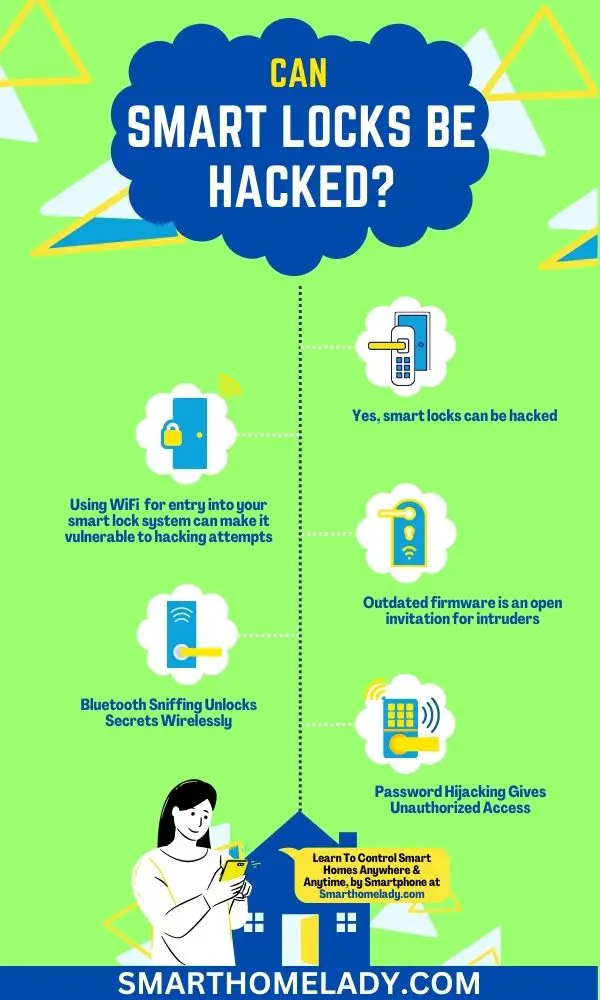
Contents
- 1 Can smart locks be easily hacked? Unveiling Vulnerabilities
- 2 How Can Your Smart Lock Be Hacked – Exposing 5 Weak Spots
- 3 How Can You Prevent Hacking Of Smart Lock – 6 Proven Strategies
- 3.1 1. Buy from Trusted Brands To Shield Your Security
- 3.2 2. Seal the Digital Vulnerabilities By Updating Firmware
- 3.3 3. Use Two-Factor Authentication (2FA) To Double the Protection
- 3.4 4. Stronger Password Constructs an Impenetrable Wall
- 3.5 5. Use Smart Lock With AES Encryption To Lock Out Unauthorized Intruders
- 3.6 6. Check ANSI grade rating To Ensure Safety Standards
- 3.7 Are smart locks hackable?
- 3.8 Can fingerprint door locks be hacked?
- 3.9 Is there a smart lock that can’t be hacked?
- 3.10 What are the risks of smart door lock?
- 3.11 Can Yale Smart Locks Be Hacked?
- 3.12 Can Schlage Smart Locks Be Hacked?
- 3.13 Are smart locks really secure?
- 4 Conclusion
Can smart locks be easily hacked? Unveiling Vulnerabilities
Yes, smart locks can be hacked. Unfortunately, recent studies have shown that almost 37% of smart locks are vulnerable to hacking. This means it’s crucial to be aware of the potential risks associated with using a smart lock and take steps to protect yourself.
One way to protect yourself is to invest in a smart lock that has high levels of encryption and security features. This will make it harder for hackers to gain access to your home or office.
Additionally, it’s important to keep your smart lock updated with the latest firmware and software updates to ensure that it’s as secure as possible.
Many smart locks come with additional security features like two-factor authentication and encryption, which can make them even more difficult to hack.
Read More:
- Does Schlage Make A Smart Key Lock?
- Why Schlage Smart Lock Drain Battery?
- How Long Do Smart Door Lock Batteries Last?
So, while smart locks may not be 100% foolproof, they are generally considered to be a safe and secure way to protect your home or business.
Remember – No technology is completely immune to hacking, but by taking proper precautions, you can greatly reduce the risk of your smart lock being hacked.
How Can Your Smart Lock Be Hacked – Exposing 5 Weak Spots
As a smart lock user, you should be aware of the potential vulnerabilities that can lead to a breach of your security. Following are 5 common weak spots that can make your smart locks hackable.
1. WiFi Breaching – A Gateway For Intrusion
You might be surprised to learn that using WiFi as a means of entry into your smart lock system can make it vulnerable to hacking attempts.
The reason for this is that WiFi networks are susceptible to various security vulnerabilities, such as weak passwords, outdated encryption methods, and network vulnerabilities.
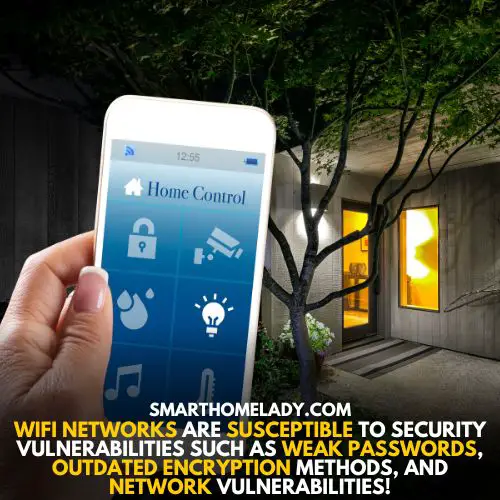
With the increasing number of devices connected to our home networks, hackers have more opportunities to exploit these weaknesses and gain access to our smart locks.
To better understand how WiFi breaches can lead to smart lock hacks, let’s take a look at the table below, which outlines common hacking techniques and their corresponding security protocols.
By examining the table, we can see that each technique has its own specific vulnerability that a skilled hacker can exploit.
| Hacking Technique | Vulnerability | Security Protocol |
|---|---|---|
| Brute force attack | Weak password | Strong password policy |
| Man-in-the-middle attack | Outdated encryption method | Updated encryption protocol |
| Packet sniffing | Unsecured network traffic | Encrypted communication protocol |
It is important for users of smart locks to be aware of these potential threats and take necessary precautions, such as updating firmware regularly and using strong passwords with their wifi network.
2. Outdated Firmware Is An Open Invitation for Intruders
If you haven’t updated the firmware on your home security system recently, it’s like leaving a window open for burglars to climb through.
The importance of firmware updates and security patches cannot be overstated when it comes to IoT security.
Outdated firmware can leave your smart lock vulnerable to attack, as it may contain known vulnerabilities that haven’t been patched with the latest software update.
Regularly updating your system’s firmware is essential in protecting against potential cyber threats. It’s also important to conduct vulnerability assessments periodically to ensure that any weaknesses in the system are identified and addressed promptly.
Don’t take chances with outdated firmware – stay on top of updates and protect your home from intruders.
3. Bluetooth Sniffing Unlocks Secrets Wirelessly
Did you know that with Bluetooth sniffing, intruders can wirelessly access your personal information without even being in your home?
This technique involves intercepting and decoding wireless signals transmitted between devices within range.
Smart locks are not exempt from this vulnerability, and as such, they can be easily hacked using Bluetooth sniffing.
Here are 5 things to keep in mind:
- Bluetooth sniffing is a passive attack method that doesn’t require any active participation from the attacker.
- Wireless vulnerabilities in smart locks are often caused by outdated firmware or encryption weaknesses.
- Signal interception can occur within a radius of several meters around the device, depending on the strength of the signal emitted by the lock.
- Remote hacking is also possible if the attacker manages to gain control over an authorized device paired with the smart lock.
To prevent Bluetooth sniffing attacks, it’s crucial to keep your firmware updated and use strong passphrases when setting up your smart lock.
Imagine finding out that someone’s gained unauthorized access to your personal accounts and information through password hijacking. This is one of the most common ways in which smart locks can be hacked.
Password cracking techniques, such as brute force attacks, social engineering hacks, phishing attempts, and keylogging methods, are used by hackers to gain access to passwords and unlock smart locks.
- Brute force attacks involve trying multiple combinations of passwords until the right one is found.
- Social engineering hacks use psychological tactics to trick individuals into revealing their passwords.
- Phishing attempts involve sending fake emails or messages that appear legitimate but actually aim to steal login credentials.
- Keylogging methods involve recording keystrokes on a device and using them later to obtain passwords.
To prevent password hijacking, it’s important to create complex passwords with a mix of letters, numbers, and symbols, enable two-factor authentication whenever possible, and avoid clicking on suspicious links or downloading unknown attachments.
5. Voice Commands Hack – When Your Words Become a Security Breach
In recent years, many smart lock manufacturers have added voice recognition capabilities to their products. While this feature can be convenient, it also comes with limitations and potential risks.
One of the main concerns is the possibility of hacking through voice commands. Hackers might use a recording of your voice or even a synthetic voice to gain access to your home.
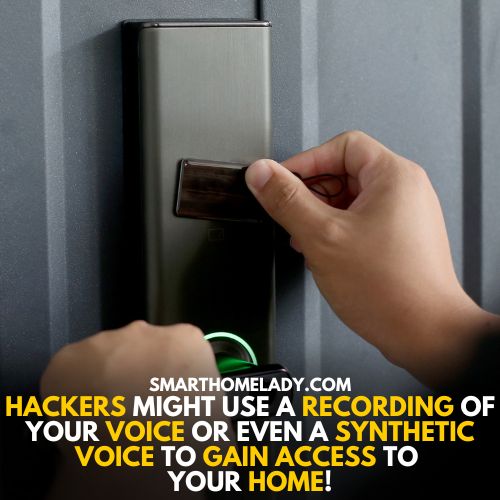
However, some measures can prevent this from happening.
For instance, some smart locks require a specific phrase or word before unlocking the door. This way, even if someone else knows your password and tries to use their voice to unlock the door, they won’t be successful without saying the correct phrase first.
As always, when it comes to technology and security, ethical concerns arise as well.
It’s important for manufacturers to prioritize safety and privacy over convenience and profitability when implementing new features like these in their products.
Read More:
- How Do Smart Door Locks Get Power?
- How To Open Smart Door Locks – Step-By-Step Guide
- Can You Put A Smart Lock On Security Door?
How Can You Prevent Hacking Of Smart Lock – 6 Proven Strategies
To prevent hacking of your smart lock, there are 6 proven strategies that you can implement. I will recommend you follow these steps closely for optimal security when using smart locks in your home or office.
1. Buy from Trusted Brands To Shield Your Security
Purchasing smart locks from reputable brands can provide an added layer of protection for your home security. Trusted brand reliability is important because it ensures that the lock will function properly and securely.
It’s also essential to check if the smart lock has certification standards, such as UL or ANSI/BHMA, which confirms that they’ve undergone rigorous testing and meets industry standards.
Furthermore, a trusted brand should offer installation guidance to make sure that the process is done correctly. This includes providing clear instructions and videos on how to install the lock properly.
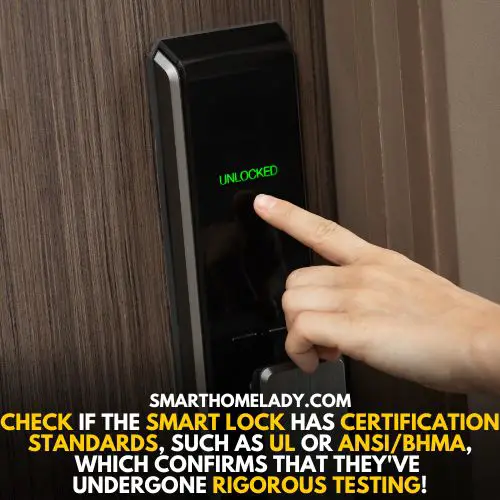
Customer support should also be readily available in case there are compatibility issues or technical problems encountered during installation or use.
By choosing a trusted brand with a proven track record, you can ensure that your investment in a smart lock will provide both convenience and security for your home.
2. Seal the Digital Vulnerabilities By Updating Firmware
Ensure your home security is up-to-date by regularly updating the firmware on your smart lock. Firmware updates are essential to enhance digital security and protect against cyber threats.
Vulnerability management is a critical aspect of maintaining smart home security. Firmware updates provide patches that address known vulnerabilities and strengthen the overall protection of your system.
Neglecting these updates exposes you to potential cyber-attacks that can compromise your personal data and put your loved ones at risk.
By staying vigilant and keeping up with regular firmware updates, you can rest assured that you have taken proactive steps toward securing your home and protecting those closest to you.
3. Use Two-Factor Authentication (2FA) To Double the Protection
By using two-factor authentication (2FA), you can add an extra layer of protection to your smart home security system. This multi-factor security technique requires you to provide two forms of user verification before granting access.
The first factor is usually a password or PIN, while the second may include biometric identification like fingerprints or facial recognition.
Here are three ways 2FA can help secure your smart lock mechanism:
- Advanced encryption – By requiring two forms of authentication, 2FA utilizes advanced encryption algorithms, making it more difficult for hackers to gain unauthorized access.
- User verification techniques – With 2FA, you have the option to choose from multiple user verification techniques, including fingerprints, facial recognition, and voice recognition. This allows you to customize your security measures according to your preferences.
- Double authentication – Two-factor authentication provides an added layer of protection by requiring not just one but two forms of user verification before granting access. This makes it much harder for hackers to bypass your security system and gain entry into your home or office without permission.
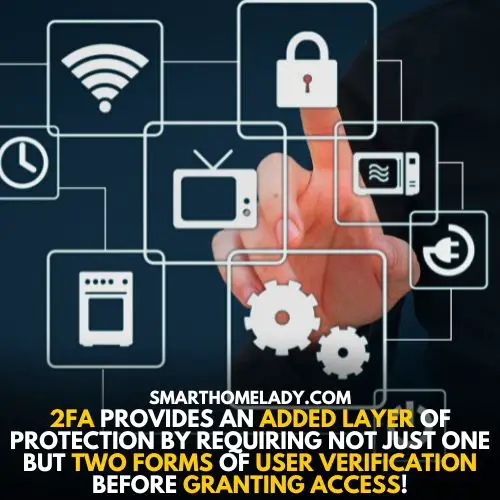
4. Stronger Password Constructs an Impenetrable Wall
Creating a strong password with a combination of uppercase and lowercase letters, numbers, and symbols can provide an impenetrable wall of protection for your smart home security system.
But it’s not just about having a complex password – you should also consider using a passphrase instead of a password. This is because passphrases are longer and harder to crack compared to typical passwords.
In addition to passwords and passphrases, biometric authentication methods such as fingerprint recognition or facial recognition can provide an extra layer of security.
However, physical tampering or remote hacking methods can still bypass these authentication methods.
Did you know that not all smart locks are created equal? Some may have weaker encryption algorithms, making them more vulnerable to hacking attempts.
So, how can you ensure your smart lock is truly impenetrable?
One solution is to choose a smart lock with AES encryption technology. This type of encryption has been proven to be highly effective in protecting against unauthorized access, both locally and remotely.
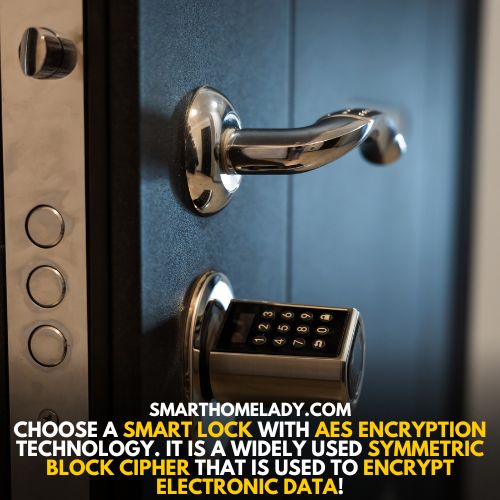
To help you make an informed decision when choosing a smart lock, here are three key benefits of using AES encryption:
- It offers superior protection against brute-force attacks, making it nearly impossible for hackers to decipher encrypted data.
- It provides end-to-end security between the device and the server, ensuring that data remains private even if intercepted during transmission.
- It supports remote access management through secure cloud-based platforms, allowing users to monitor and control their locks from any location with internet access.
By choosing a smart lock with these advanced security features, you can rest assured that your home or office will remain safe and secure from potential intruders or cyber attackers.
6. Check ANSI grade rating To Ensure Safety Standards
To ensure your safety, make sure to check the ANSI grade rating when selecting a lock for your home or office.
The ANSI (American National Standards Institute) has established standards for lock performance and durability that are used industry-wide.
By choosing a lock with an appropriate ANSI grade rating, you can be confident that it meets specific criteria for strength, reliability, and resistance to physical attacks.
The ANSI grade rating is determined by testing the lock against various techniques commonly used by intruders, including lock picking, lock bumping, and drilling.
The higher the grade number (1-3), the more secure the lock is deemed to be.
It’s important to note that even high-grade locks may still be vulnerable if they are not installed properly or maintained appropriately.
However, checking the ANSI grade rating is a good starting point in ensuring that your property is adequately protected against unauthorized access.
| Grade Rating | Criteria |
|---|---|
| Grade 1 – Best | Highest Level Of Residential Security – withstands 800k cycles |
| Grade 2 – Better | Moderate Residential Security – withstands 400k cycles |
| Grade 3 – Good | Basic Residential Security – withstand 200k cycles |
This table highlights some of the key criteria used in determining an ANSI grade rating. As you can see, higher grades indicate greater resistance against common methods of forced entry, such as drilling and bumping.
So, by following the above ways, you can prevent hacking of your smart locks.
Frequently Asked Questions FAQs
Are smart locks hackable?
Yes, smart locks can be vulnerable to hacking. Just like any other internet-connected device, smart locks are susceptible to cyber-attacks.
Hackers can exploit weaknesses in the lock’s software or network or even use brute force to gain access.
However, it’s important to note that not all smart locks are created equal. Some smart locks are more secure than others, and it’s important to do your research before making a purchase.
Look for locks that have strong encryption, two-factor authentication, and regular software updates to minimize the risk of hacking.
Can fingerprint door locks be hacked?
Yes, fingerprint door locks can be hacked. Although they are considered more secure than traditional locks, they are not foolproof.
Hackers can try to replicate fingerprints or use other methods to gain access to the lock.
However, fingerprint door locks are still a good option for home security. They provide an extra layer of protection, and many models come with additional security features like PIN codes or Bluetooth connectivity.
Just be sure to choose a reputable brand and follow best practices for securing your home network to minimize the risk of hacking.
Is there a smart lock that can’t be hacked?
While there is no smart lock that is entirely hack-proof, some locks are more secure than others.
For instance, high-end smart locks like August Smart Lock Pro and Schlage Encode have advanced security features that make them harder to hack.
These locks use advanced encryption protocols, biometric authentication, and other security features that can prevent unauthorized access.
However, it’s essential to note that no lock is entirely hack-proof, and it’s vital to take measures such as changing your password regularly to minimize the risk of a breach.
What are the risks of smart door lock?
The risks of using a smart door lock are relatively low if you take the necessary security precautions. However, as with any technology, there is always a risk of a security breach.
For instance, if someone gains access to your smartphone or login credentials, they could easily unlock your smart lock.
Additionally, smart locks that rely on Wi-Fi connectivity are vulnerable to hacking if the network is not adequately secured.
To minimize the risk of a breach, using strong passwords, enabling two-factor authentication, and keeping your smartphone and network secure is essential.
Can Yale Smart Locks Be Hacked?
The answer is yes; they can be hacked. However, the likelihood of a hack occurring is minimal due to the advanced security features that Yale smart locks come with.
Furthermore, Yale smart locks are designed to alert you in case of any suspicious activity, and they allow you to monitor and control access to your home remotely.
To ensure maximum security, it is important to keep your software updated and use strong passwords.
Can Schlage Smart Locks Be Hacked?
Like any electronic device, Schlage smart locks may be vulnerable to hacking if proper security measures are not taken.
Schlage regularly updates its firmware to address any security vulnerabilities that may arise. To further enhance security, it is recommended to use strong passwords and enable two-factor authentication.
Are smart locks really secure?
In general, smart locks can be secure if installed and configured correctly and if they use strong encryption and authentication protocols.
However, like any technology, they are not foolproof and can be vulnerable to hacking or other security breaches.
Choosing a reputable brand and following best practices for securing your smart lock is important, such as using strong passwords and regularly updating firmware.
It is also recommended to have a backup physical key in case of any malfunctions or security issues.
Conclusion
So, can smart locks be hacked? While smart locks offer convenience and added security to our homes, they are not immune to hackers. It is essential to choose a smart lock from a reputable brand and keep it updated with the latest firmware.
Additionally, users must practice good cybersecurity habits, such as using strong and unique passwords and enabling two-factor authentication.
By taking these precautions, we can reduce the risk of our smart locks being hacked and ensure that our homes remain safe.
Don’t wait until it’s too late; take action today to secure your smart lock and protect your home.


